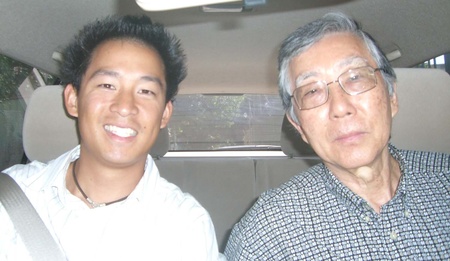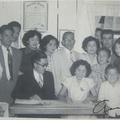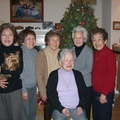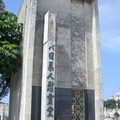The future of a culture often relies on its ties to the past. Many Japanese Cubans do not have strong ties to their Japanese heritage. The small quantity of Japanese Cubans has limited the strength and capabilities of Japanese organizations and institutions. Unlike Peru, Brazil, and the United States where large Japanese communities reside, Japanese Cubans do not have sufficient numbers to drive demand for Japanese language or history courses, nor music or dance lessons. In the United States, well-to-do Nisei have donated money to museums, schools, universities, and non-profit organizations to continue passing the knowledge of Japanese language, history, and culture. Furthermore, as a result of the Cuban state-run market economy, Japanese Cubans today find it very hard to accumulate enough capital to sustain strong and dynamic cultural associations.
The Revolution has somewhat diluted the Japanese Cuban identity. The Revolution views every individual first and foremost as a Cuban. The Revolution is color-blind, and in practice it has been fairly successful. Most Japanese Cubans interviewed knew they were different, particularly the ones who still maintained a Japanese surname, but non-Japanese Cubans saw them as equals, as Cubans. None of the Japanese Cubans interviewed felt any sense of racism or inferiority from their Cuban neighbors. However, some of the Nisei Japanese Cubans interviewed said that most of the fear of the Japanese population came from the government, and not their neighbors, friends, or from the general public.
During World War II the Cuban government showed movies similar to the ones in America which portrayed the Japanese as ugly sub-human caricatures. Many Japanese Cubans were greatly aided by their non-Japanese neighbors while the Japanese men were interned away on the Island of Pines (La Isla de Pinos, or now renamed La Isla de Juventud). The Japanese women were left to tend to not only their personal lives, but often many of them had children to feed and clothe as well.
Reflecting on this tumultuous time in his childhood, Francisco Miyasaka notes that “we also survived because there was a great deal of help and solidarity on the part of the Cubans. Cuban families, acquaintances, school friends, etc., … the women and children of those who were interned were grateful for the support of the Cuban families. Thanks to many of them, we were able to survive and to have a decent life during that time.”1
There has never been an official apology from the Cuban government regarding the internment of Japanese Cubans, according to First Secretary Ono.2 Many Japanese Cubans, like many Japanese Americans and other Japanese in Latin America, feel that revisiting this topic will bring back ill-feelings and will only serve to weaken Cuban unity. But as former American President George H.W. Bush stated quite candidly: “in remembering, it is important to come to grips with the past. No nation can fully understand itself or find its place in the world if it does not look with clear eyes at all the glories and disgraces of its past.”3
For better or for worse, addressing this issue would help elevate the Japanese Cuban community to a more prominent spotlight. It will be interesting to see if the Japanese Cuban community ever gathers the momentum, or interest, to broach this subject with the Cuban government. It is highly unlikely to occur during the Castro regime.
Another impediment is that the Cuban government has not officially recognized the Japanese Cuban Association. The paperwork has been submitted but approval has been forthcoming for years now. While official recognition is not necessary to carry out functions of the Association, it would help its credibility. The Cuban government does not frequently issue permits of this kind as it discourages the formation of groups which serve to differentiate Cubans. If the group were made official they could establish official links with Japanese government and Nikkei organizations abroad, exchange visits, and receive financial support from them.4 This money could be used to purchase Japanese educational materials, assist Japanese Cuban families who are in dire financial need, or used to acquire other needs of the Association.
Francisco Miyasaka, President of the Japanese Cuban Association, toured California in 2001 and 2002, visiting universities and other organizations with the intent of spreading awareness of the Japanese Cuban community. Miyasaka visited Los Angeles, San Francisco and Oakland to raise funds to purchase a TV and VCR for every province in Cuba so they could show informational videos on Japanese culture, language and history.

The Japanese government prefers to approach cultural exchange by promoting private organizations.5 This approach is difficult seeing as private enterprise by Japanese Cubans is close to impossible. Also, the Helms-Burton Act has deterred Japanese investors from entering the Cuban market, making it even more difficult for the Japanese government to assist the Japanese Cuban community through the (virtually non-existent) private sector.
As Mr. Miyasaka has pointed out, the creation of the Cuban Japanese Society would allow the Nikkei to “establish official links with Japanese and Nikkei organizations abroad, to exchange visits, and to get support from them. We would be able…to get economic help and support from…the Japanese government. This support in money and goods would be decisive in the creation of a nationwide organization and its functioning. It would also give our organization the possibility to help Nikkei families who may be facing difficult economic situations.”6
Next chapter: “Strengthening the Japanese Cuban Community” >>
Notes:
1. Ropp, Steven Masami and Romy Chávez de Ropp. “An Interview with Francisco Miyasaka: President of the Japanese Cuban Association.” Amerasia Journal 28:2 (2002). University of California, Los Angeles. P. 135.
2. Interview. Masayoshi Ono. Japanese Embassy, Havana, Cuba. August 17, 2006.
3. Conrat, Maisie & Richard. Executive Order 9066: The Internment of 111,000 Japanese Americans. Asian American Studies Center, University of California, Los Angeles: 1992. P. 10.
4. Email Correspondence with Francisco S. Miyasaka. Nov 5, 2006.
5. Ohara, Yoshinori. Japan and Latin America. Memorandum RM-5388-RC. The RAND Corporation, 1967. P. 57.
6. Email Correspondence with Francisco S. Miyasaka. Nov 5, 2006.
* This article is an excerpt from the master’s research project, “Japanese Cubans: Past, Present, and Future,” by Christopher David Cheng (Middlebury Institute of International Studies at Monterey, December 19, 2006).
© 2006 Christopher David Cheng





